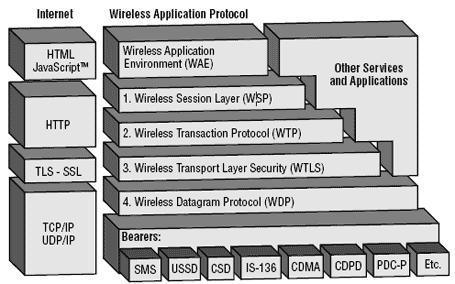Wireless Application Protocol (WAP)
Wireless Application Protocol (WAP) is a technical standard for accessing information over a mobile wireless network. A WAP browser is a web browser for mobile devices such as mobile phones that uses the protocol. Introduced in 1999, WAP achieved some popularity in the early 2000s, but by the 2010s it had been largely superseded by more modern standards. Most modern handset internet browsers now fully support HTML, so they do not need to use WAP markup for web page compatibility, and therefore, most are no longer able to render and display pages written in WML, WAP's markup language.
WAP is designed in a layered fashion, so that it can be extensible, flexible, and scalable. As a result, the WAP protocol stack is divided into five layers −
Layers of WAP Protocol
Application Layer
Wireless Application Environment (WAE). This layer is of most interest to content developers because it contains among other things, device specifications, and the content development programming languages, WML, and WMLScript.
Session Layer
Wireless Session Protocol (WSP). Unlike HTTP, WSP has been designed by the WAP Forum to provide fast connection suspension and reconnection.
Transaction Layer
Wireless Transaction Protocol (WTP). The WTP runs on top of a datagram service, such as User Datagram Protocol (UDP) and is part of the standard suite of TCP/IP protocols used to provide a simplified protocol suitable for low bandwidth wireless stations.
Security Layer
Wireless Transport Layer Security (WTLS). WTLS incorporates security features that are based upon the established Transport Layer Security (TLS) protocol standard. It includes data integrity checks, privacy, service denial, and authentication services.
Transport Layer (Wireless Datagram Protocol)
Wireless Datagram Protocol (WDP). The WDP allows WAP to be bearer-independent by adapting the transport layer of the underlying bearer. The WDP presents a consistent data format to the higher layers of the WAP protocol stack, thereby offering the advantage of bearer independence to application developers.
Each of these layers provides a well-defined interface to the layer above it. This means that the internal workings of any layer are transparent or invisible to the layers above it. The layered architecture allows other applications and services to utilise the features provided by the WAP-stack as well. This makes it possible to use the WAP-stack for services and applications that currently are not specified by WAP.
The WAP protocol architecture is shown below alongside a typical Internet Protocol stack.

Note that the mobile network bearers in the lower part of the figure above are not part of the WAP protocol stack.
Recommended posts:-
- Cyber law or IT law
- IEEE 802.11
- Data broadcasting
- MAC issues
- BluetoothTechnology
- Routing and various Routing algorithm
- wireless LAN
- Mobile agents in mobile computing
- TCP over wireless
- Issuse in Mobile computing
- Handoff or Handover
- Wireless Telephony:object,feature and application
- Application of wireless communication

If you have any doubts. Please let me know ConversionConversion EmoticonEmoticon